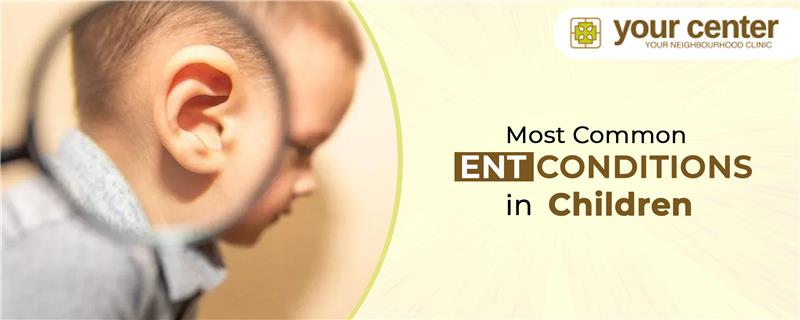
Ear, nose, and throat (ENT) diseases are a very sensitive type of condition that can occasionally visit a person’s life, and it is more often for children's because they are always involved in some troublesome activities. And that’s why it is important to grab proper knowledge of these ENT conditions so that, as a parent, you are always aware of these diseases and can get solutions immediately. And in this blog, we will provide all necessary information related to ENT conditions in children's.
Some Common ENT Conditions in Children
1. Ear Infections (Otitis Media)
Ear infections are one of the most common ENT diseases in children. They occur when fluid builds up behind the eardrum, leading to inflammation and infection.
Symptoms: Ear pain, trouble hearing, irritability, fever, and fluid drainage from the ear.
Causes: Bacterial or viral infections, often after a cold or respiratory illness.
Treatment: Mild cases may resolve on their own, but antibiotics are prescribed for bacterial infections. In some cases, ear tubes may be recommended to prevent chronic infections.
2. Tonsillitis
Tonsillitis is the inflammation of the tonsils, that usually located at the back of the throat. This condition is common in children and can cause throat pain and difficulty swallowing.
Symptoms: Sore throat, red and swollen tonsils, fever, difficulty swallowing, and bad breath.
Causes: Viral or bacterial infections, including the common cold and streptococcus bacteria.
Treatment: For viral tonsillitis, rest, fluids, and over-the-counter medications are usually enough. Bacterial tonsillitis may require antibiotics. Chronic tonsillitis may require tonsil removal (tonsillectomy). You can also visit a Pediatrician for better understanding.
3. Sinusitis (Sinus Infections)
Sinusitis occurs when the tissue lining the sinuses becomes inflamed, often due to infection or allergies. This condition is common in children and can cause persistent cold-like symptoms.
Symptoms: Runny or stuffy nose, facial pain, headache, cough, and thick yellow or green mucus.
Causes: Bacterial, viral infections, or allergies.
Treatment: Mild sinus infections may clear up with rest, hydration, and nasal saline sprays. Antibiotics may be needed for bacterial sinusitis. Allergy management can help prevent recurring sinus infections.
Contact Now: Visit for Best Pharmacy Services.
4. Adenoid Hypertrophy
The adenoids are lymphatic tissue located behind the nasal cavity, and when they become enlarged, they can cause breathing and sleeping problems in children.
Symptoms: Difficulty breathing through the nose, mouth breathing, snoring, and recurrent ear infections.
Causes: Frequent infections or allergies can cause the adenoids to become enlarged.
Treatment: Mild cases may not require treatment, but severe cases may involve surgery to remove the adenoids (adenoidectomy).
5. Allergic Rhinitis (Hay Fever)
Allergic rhinitis, usually recognized as hay fever, and it’s an allergic reaction that affects the nose. It is triggered by allergens such as pollen, dust, and pet dander, and it is particularly common in children with a family history of allergies.
Symptoms: Runny nose, itchy eyes, sneezing, nasal congestion, and coughing.
Causes: Exposure to airborne allergens like pollen, dust mites, mold, and pet dander.
Treatment: Antihistamines, decongestants, and nasal corticosteroid sprays can help to provide relief in this condition. Allergy shots or immunotherapy may be recommended for long-term relief.
Contact Now: Book Appointment if you are Allergic.
6. Nasal Polyps
Nasal polyps are noncancerous development in the lining of the nasal passages or sinuses. Though rare in children, they can cause chronic breathing problems and infections when they do occur.
Symptoms: Chronic nasal congestion, loss of sense of smell, runny nose, and facial pain.
Causes: Chronic inflammation of the nasal passages, often due to allergies or infections.
Treatment: Nasal sprays, oral steroids, and in some cases, surgery may be needed to remove large polyps.
7. Croup
Croup is a viral infection that affects the larynx (voice box), trachea (windpipe), and bronchi (airways). It’s characterized by a distinctive "barking" cough and is most common in children under five.
Symptoms: Barking cough, hoarse voice, difficulty breathing, and a high-pitched whistling sound when inhaling (stridor).
Causes: Viral infections, such as the parainfluenza virus.
Treatment: Mild cases can be managed with rest, hydration, and a cool-mist humidifier. Severe cases may require corticosteroids or nebulized treatments to reduce airway swelling.
8. Obstructive Sleep Apnea (OSA)
Obstructive Sleep Apnea (OSA) is a sleep disorder where a child’s breathing is interrupted during sleep due to airway blockages, often caused by enlarged tonsils or adenoids.
Symptoms: Snoring, restless sleep, gasping or choking during sleep, daytime sleepiness, and behavioral issues.
Causes: Enlarged tonsils and adenoids are the most common cause of OSA in children.
Treatment: Treatment options include weight management, removal of the tonsils and adenoids, or the use of continuous positive airway pressure (CPAP) machines.
9. Earwax Buildup
Earwax (cerumen) is a natural substance that protects the ear canal, but excessive earwax buildup can cause discomfort and hearing issues in children.
Symptoms: Ear pain, hearing loss, and experiencing a fullness in the ear.
Causes: Overproduction of earwax or improper ear cleaning methods.
Treatment: Earwax can be safely removed by a healthcare professional. Home treatments, such as ear drops, can also soften and remove wax buildup.
10. Swimmer’s Ear (Otitis Externa)
Swimmer’s ear is an infection of the outer ear canal, commonly caused by water remaining in the ear after swimming, creating a moist environment for bacteria to grow.
Symptoms: Ear pain, itching, redness, and fluid drainage.
Causes: Bacterial infections, often after swimming or exposure to moisture.
Treatment: Antibiotic ear drops are usually effective in treating swimmer’s ear. Keeping the ears dry and avoiding swimming during the infection is recommended.
Contact Now: For Home Care Services.
Conclusion
So as you read this blog, now you may have proper information on ENT conditions in children, but still, getting consultation from an expert pediatrician in Dubai is really important, and in our opinion, you should visit or contact Yourcenter Polyclinic for effective treatment.


